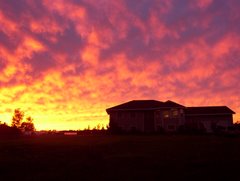But I was looking at the lawn the other day realizing that the only thing our lawn has in common with most city lawns is the fact that, once it is mowed, it's green. Our lawn has grasses ... many varieties. At least three varieties of clover. Queen Anne's Lace. Birdsfoot Trefoil. Chamomile. Pearly Everlasting (drifts of this weed are beautiful, in my opinion). Plantain. Wild Yarrow. And thousands of other weeds, which still manage to look somewhat like lawn once they are mowed. In the heat of drought, when the grasses have given up their fight, the lawn is still green with tougher plant life. Last August, after a whole summer without rain, our lawn was mainly clover and trefoil at one side of the house.
The other advantage to an eclectic rural lawn?

I watched the kildeer parents making their nest for about a week before she laid eggs. A killdeer nest is nothing much; merely a depression in the vegetation. And the eggs are very hard to see; I mightn't have found the nest had I not seen preparations underway. I am fascinated by how these eggs are arranged ... all point side down, almost perfectly symmetrical. Every year we have a few nests, but this is our first "four-egg" nest. Some years we never even glimpse the babies; the eggs hatch and mom and dad move them on. Terrestrial birds' babies are far more advanced at birth that other baby birds; they scurry around looking for food pretty much as soon as they are hatched. Here's a borrowed photo since the chances of me snagging one are slim:

I'm sure that most of you have watched a mother killdeer's antics while protecting their nest; they pull the "broken wing" ploy and drag their wing helplessly in the opposite direction.
Recent news has that terrestrial birds are on the decline due to habitat destruction. Because of this, I feel blessed that our, uh, "faux lawn" can multi-purpose in this way.
Oh yes, and by the way, the silvery grey plant in the first photo is "pearly everlasting". It grows in clumps and drifts, and practically glistens when covered with morning dew. Historically, it has been used for medicinal purposes. Nowadays, it's "just" a weed.


No comments:
Post a Comment